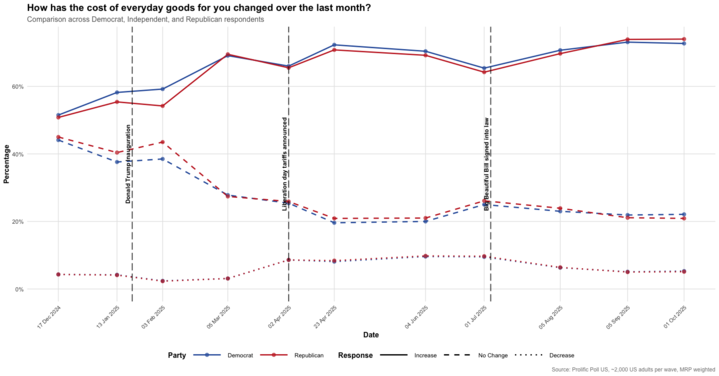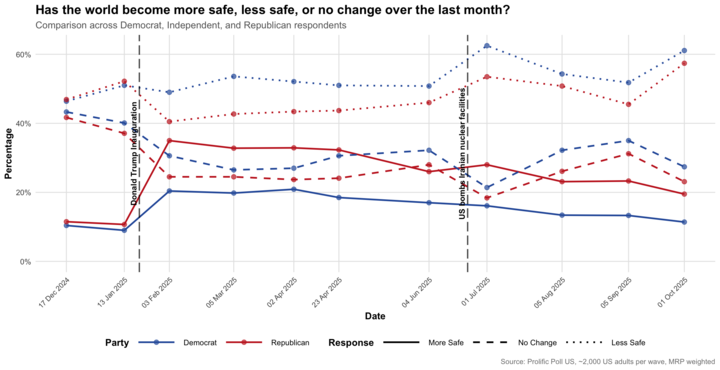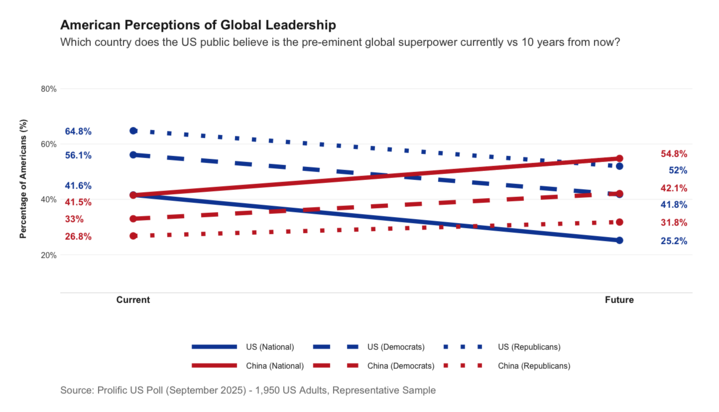The double squeeze: Trump's base reports rising costs and a more dangerous world
Nine months of polling data since Donald Trump's inauguration reveals a troubling trend for the administration: Republicans are increasingly reporting rising costs and growing safety concerns.
When Donald Trump was on the campaign trail he promised his supporters two things: economic prosperity and a stronger, safer America. Nine months into his second term, Prolific's continuous tracking of American political sentiment is starting to reveal a different story. Among all voters economic anxiety has dramatically increased since the inauguration while perceptions of global safety have declined. Democrats, predictably, report worsening conditions, but that's the expected outcome when your political opponents control all three branches of government. What's significant, and likely politically consequential, is that Trump's own voters are now experiencing the same deterioration in their fortunes and perceptions.
Economic Deterioration: A Bipartisan Reality with Different Implications

Every month since December 2024, we've asked a representative sample of roughly 2,000 US adults: "How has the cost of everyday goods for you changed over the last month?"
Among Republicans, the surge has been dramatic:
- At Trump's inauguration in January 2025: ~53% reported cost increases
- By October 2025: ~73% report cost increases
- That's a 20-percentage-point increase in nine months
Democrats tell a similar story:
- January 2025: ~59% reported cost increases
- October 2025: ~75% report cost increases
- A 16-percentage-point increase
The trajectories are more or less parallel for both sets of voters, showing that both groups are experiencing increasing economic pressure. This convergence is particularly striking given that our other polling questions consistently show large partisan divides. For example, when we ask about Trump’s favourability ratings or our spotlight questions on specific policy issues, we see the expected partisan gaps you'd find in any political survey. But on these cost-of-living questions, Republicans and Democrats are reporting nearly identical experiences. That convergence isn't an artifact of our methodology, it's a signal that something real is happening in Americans' daily economic lives that transcends political identity. The political meaning behind that shared experience, however, could not be more different.
We believe these tracking questions reveal more authentic beliefs precisely because they lack obviously salient partisan cues. When we ask "How has the cost of everyday goods for you changed over the last month?" or "Has the world become more safe, less safe, or stayed the same?" we're not explicitly invoking Trump, Biden, or any political figure. Respondents aren't being asked to evaluate their team versus the other team. They're being asked about their direct experience. This design choice helps us capture what people are actually feeling rather than what their partisan identity tells them they should be feeling.
Democrats didn't vote for Trump partly for fear of economic consequences, many Democrats expected that Trump's policies would hurt them. Indeed Kamala Harris based a large part of her campaign pitch to the US public on the risk to the economy under a Trump administration. Our data confirms their fears, but they saw it coming.
Republicans voted specifically for economic improvement. They believed Trump's tariffs, tax cuts, and deregulation would ease their financial burden, because that's what he told them. Instead, they're experiencing the same cost spiral as everyone else, perhaps worse, given they started from a slightly better position and ended up in the same place.
The "no change" responses tell the same story across both groups: collapsing from around 40% down to around 21% for both parties. Meanwhile, those reporting decreases in the cost of everyday goods remain essentially zero. Nobody is catching a break, but Republicans expected one.
The timing here is important. Trump's aggressive trade agenda launched immediately after his inauguration with 25% tariffs on Mexico and Canada in February. By April, he'd announced his “Liberation Day tariffs” on virtually every trading partner in what The Economist called "the biggest trade policy shock in history". Then came continued waves of tariffs: 50% on copper, 100% on pharmaceuticals, 25% on furniture, 10% on lumber, and dozens more. Each tariff is a tax paid by American consumers, Democrat and Republican alike. Our data captured the impact in real-time: After liberation day tariffs were announced, cost-increase reports climbed for everyone. The correlation here is hard to ignore. Trump's signature economic policy appears to be harming all Americans' wallets, including his own supporters who trusted him to do the opposite.
A similar story can be seen with the introduction of the "One Big Beautiful Bill" into law on July 4, 2025. This sweeping legislative package made his 2017 tax cuts permanent, eliminated taxes on tips and overtime, and promised families would see "$10,000+ more in annual take-home pay". The Congressional Budget Office estimated it would add $3.4 trillion to the deficit over 10 years. Meanwhile, the bill cut Medicaid and food assistance programs that many working-class Americans, including Republican voters, rely on.
What actually happened? Our tracking shows the cost-increase trend didn't reverse, in fact it barely even paused. From July through October, the percentage of Republicans reporting rising costs continued its upward march, reaching the highest levels yet. The same pattern held for Democrats. For Democrats, this confirmed their belief that Trump's policies were never designed to help them. For Republicans, it was a broken promise. The policy "win" that dominated headlines translated into zero relief in voters' economic reality.
But tariffs aren't just economic policy. They're foreign policy instruments also, wielded by the Trump administration as tools of coercion, negotiation, and geopolitical positioning. Trump has applied them to pressure both allies and adversaries in an attempt to reshape the global trading system with America at its center - his "America First" doctrine that was supposed to use economic leverage to restore American dominance on the world stage. Instead, these policies appear to be achieving the opposite of their stated aims on both fronts.
From Economic Pain to Geopolitical Decline
The trade wars that are driving up costs aren't occurring in a vacuum. They're part of a broader foreign policy approach that includes confronting longtime allies, unpredictable diplomacy with adversaries, and transactional relationships that appear to be eroding decades of alliances created and maintained since the end of World War 2. The same aggressive posture driving up prices through tariffs is also reshaping America's position in the world.
And Americans are noticing. Our tracking simultaneously monitors views on foreign policy, asking: "Has the world become more safe, less safe, or stayed the same?"

Across the political spectrum, Americans increasingly report the world feels less safe. Our foreign policy data shows sustained upward trends in security concerns. Democrats see deteriorating global security, and critically, so do Republicans. The same Republican voters experiencing accelerating economic pain are simultaneously perceiving the world as becoming more dangerous. They, and all the rest of us, are caught in a double squeeze of wallets being strained at home, and threats growing abroad.
Our tracking captured these perceptions shifting in real-time. For example, in June 2025, when the US bombed Iranian nuclear sites, we saw a sharp spike in Americans reporting the world felt less safe. The escalation of tensions with a major regional power translated immediately into heightened public anxiety about global security. This marked a shift from abstract geopolitics to a concrete moment when Americans across the political spectrum recognized the stakes of aggressive foreign policy.
Intuitively this makes sense because economic warfare with trading partners strains diplomatic relationships. Tariffs on Canadian lumber and Mexican goods don't just raise prices within the US consumer market, they also antagonize America's neighbours. Similarly, 100% tariffs on pharmaceuticals and aggressive posturing against China don't just threaten supply chains, they also escalate tensions with a nuclear-armed rival. And military strikes on Iranian nuclear facilities, whatever their strategic rationale, create immediate fears of broader conflict. The question then becomes whether Americans believe this approach is strengthening America's global position or weakening it, regardless of how dangerous the world is becoming.
The Verdict: Americans Expect Decline
In September, we asked Americans which country they see as the pre-eminent global superpower today versus 10 years from now. The results revealed an interesting pattern: Republicans are significantly more optimistic than Democrats about America's current global position, but both groups expect the same trajectory of decline.

Today's reality (where we are now):
- Republicans: 64.8% see US as the pre-eminent superpower
- Democrats: 56.1% see US as the pre-eminent superpower
- Republicans start from a baseline of greater confidence in American power
But 10 years from now, both groups see similar decline:
- Republicans expect US influence to drop 12.8 percentage points (64.8% → 52%)
- Democrats expect US influence to drop 14 percentage points (56.1% → 42.1%)
- The national consensus: US down 13.7 points
Meanwhile, China's rise:
- Republicans expect China to gain 9.6 percentage points
- Democrats expect China to gain 13.3 percentage points
- The national consensus: China up 11.1 points
Read that again - Trump's own voters believe America is the global leader today. They're the optimists. But even they expect that position to significantly decline over the next decade, with China closing the gap. Starting from a place of greater confidence doesn't change the direction they see things heading. This is the ultimate indictment of "America First." Even the Americans most bullish on current US dominance expect it to weaken under Trump's policies, while China strengthens. The optimists and pessimists disagree on where America stands today, but agree on where it's headed: down.
The double squeeze isn't just about feeling economic pain while the world feels dangerous. It's about watching the very policies meant to deliver prosperity drive up costs, while the very policies meant to restore American dominance lead Americans to expect China's rise and America's decline.
Why This Matters: The Expectations Gap
Here's why Prolific launched this tracking initiative: Point-in-time polls capture static snapshots, whereas tracking reveals trajectories. Our monthly monitoring reveals trend lines moving in the wrong direction for all Americans on both economic and foreign policy fronts.
We believe these tracking questions reveal more authentic beliefs precisely because they lack obviously salient partisan cues. When we ask "How has the cost of everyday goods for you changed over the last month?" or "Has the world become more safe, less safe, or stayed the same?" we're not explicitly invoking Trump, Biden, or any political figure. Respondents aren't being asked to evaluate their team versus the other team. They're being asked about their direct experience. This design choice helps us capture what people are actually feeling rather than what their partisan identity tells them they should be feeling.
But the political implications are asymmetric:
Democrats expected Trump's policies to fail. Our data showing 59% → 75% cost increases and expectations of American decline validates their worldview. They can say "we told you so."
Republicans expected improvement. Our data showing 53% → 73% cost increases, rising safety concerns, and their own projection that America will lose ground to China represents a betrayal of expectations - they voted for economic relief and American dominance, but they're getting economic deterioration and anticipated decline instead.
The same objective reality, i.e., accelerating cost pressures and diminishing global confidence, has markedly different political meanings depending on what you expected to happen. Republicans didn't just experience the economic pain and geopolitical anxiety that Democrats did, they experienced both under a president they specifically elected to deliver the opposite, implementing policies they specifically supported to achieve American strength and prosperity.
What Comes Next
Our tracking will continue through Trump's second term. The question is whether the administration will acknowledge what the data clearly shows: their policies aren't just failing to help Americans, they're actively making things worse for everyone, including their core supporters.
The 20-percentage-point surge among Republicans reporting cost increases since inauguration isn't noise. Neither is the bipartisan expectation of American decline and Chinese rise. These are sustained patterns that correlate directly with Trump's policy choices, the confrontational approach that aims for strength but breeds instability.
The universal nature of the deterioration is the story. Trump promised his supporters they would win while others would lose, that America would dominate while China would fall back. Our data shows everyone's losing together economically, everyone feels less safe, and everyone, including Trump's own voters, expects China to gain ground on America over the next decade.
About the data: This analysis draws from Prolific's longitudinal tracking poll, launched in late 2024 to monitor six key indicators of American political sentiment. Each wave surveys ~2,000 U.S. adults, weighted via multilevel regression and poststratification (MRP) for demographic representativeness. Tracking data spans December 2024 through October 2025. The superpower perception poll surveyed 1,950 US adults in September 2025. You can interact with our data using our interactive poll tracker or by downloading the data yourself.





